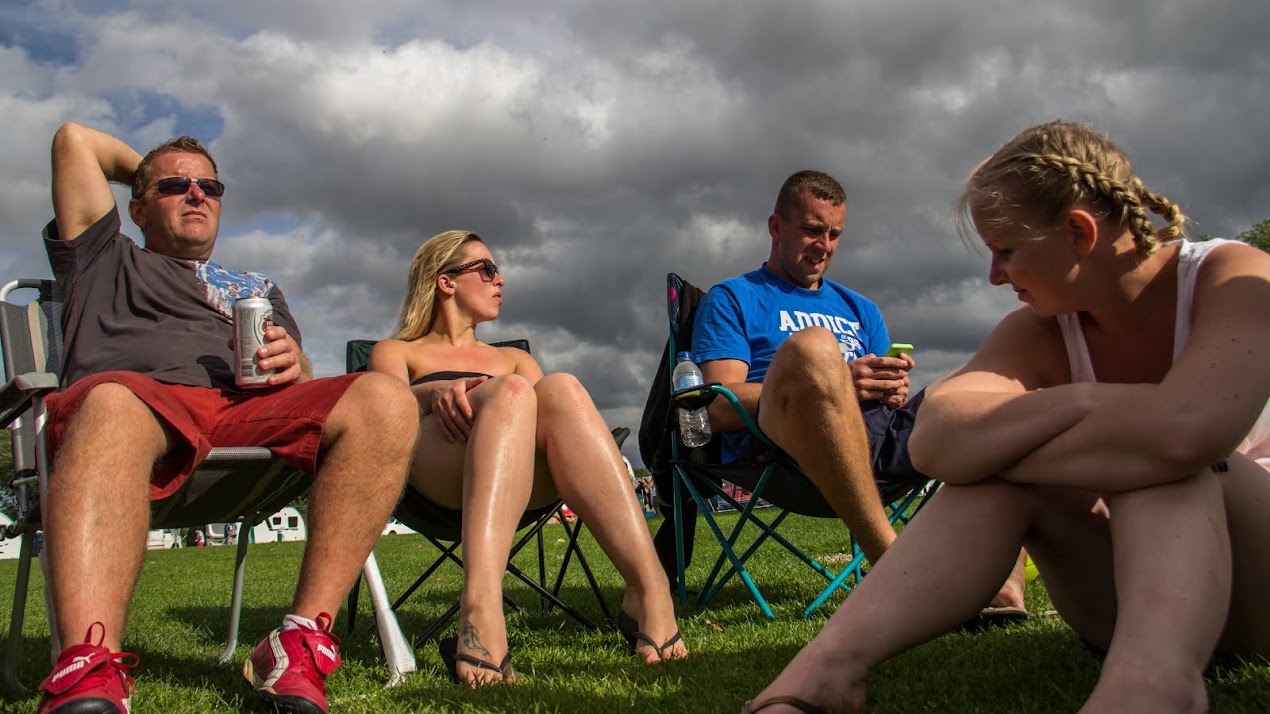Trish
Morrissey’s concept is similar to that of Lee’s, however in Morrissey’s case
she approaches families on the beach and asks to completely take on someone’s
role for the photograph, usually the mother. On first glance, this as a set isn’t
as convincing as Lee’s; something in the body language and facial expressions
of both Morrissey and the families show a slight discomfort with the situation.
This is hardly surprising, how often does a strange woman invade a family
holiday and ask to replace the mother for a family photo – visions of bunny
boilers spring to mind.
In order to create such a scene, Morrissey would have to be confident and somehow, convince them that she isn’t mad. She always wore an item of the mother’s clothing to represent her place in the picture; in the image below, it was the mother’s ring. This would require a very open minded family with a broad appreciation for art to take part in the project. If I were with a group of friends, we’d probably go for it for a laugh, however I’m not sure my family would be convinced to take part.
I feel that there is an element of voyeurism in this project, Morrissey spends half an hour or so setting up the shots, in the process probably getting to know a little about them. This is however, a very open voyeurism, far from sitting at the other end of the beach with a zoom lens, Morrissey gets right in on the action and this is only possible with full consent of the family.
In order to create such a scene, Morrissey would have to be confident and somehow, convince them that she isn’t mad. She always wore an item of the mother’s clothing to represent her place in the picture; in the image below, it was the mother’s ring. This would require a very open minded family with a broad appreciation for art to take part in the project. If I were with a group of friends, we’d probably go for it for a laugh, however I’m not sure my family would be convinced to take part.
I feel that there is an element of voyeurism in this project, Morrissey spends half an hour or so setting up the shots, in the process probably getting to know a little about them. This is however, a very open voyeurism, far from sitting at the other end of the beach with a zoom lens, Morrissey gets right in on the action and this is only possible with full consent of the family.
Morrissey
investigates further into family life in her project, ‘Seven Years’, in which
she and her sister dress up as siblings at different ages and stages of life,
maintaining their seven-year age gap. The sisters use props and clothing to
represent the era they are shooting and play characters of different sexes throughout.
The photos show classic images taken of siblings as they grow up and goes some
way to highlight the fact that many families take the same photos. The stances
shown in many of the images highlight our desire to take images in the midst of
a family event, yet we ask the subject to stop and pose first, distancing them
from the precise activity we wanted to photograph.
Morrissey’s
‘The Failed Realist’ shows a series of images of her face, painted by her
daughter between the ages of four and five. At this age infants reach The
Failed Realist stage, according to Georges-Henri Luquet, a point at which their
desire to express through mark making is beyond their physical skill. Romantic
artists such as Picasso attempted to retrieve this ability to paint like a
child, beliving it to be a more pure form of art.
Morrissey’s daughter loved to face paint and the series, The Failed realist shows images of her interpretations of things seen in films, events and dreams.
Morrissey’s daughter loved to face paint and the series, The Failed realist shows images of her interpretations of things seen in films, events and dreams.
References:
Morrissey
T, (2006) Trish Morrissey [online]. At http://www.trishmorrissey.com/works_pages/work-front/workpg-06.html
(accessed 31/8/15)
Morrissey
T, (2006) Trish Morrissey [online]. At http://www.trishmorrissey.com/works_pages/work-tfr/statement.html
(accessed 31/8/15)
Morrissey
T, (2006) Trish Morrissey [online]. At http://www.trishmorrissey.com/works_pages/work-sy/statement.html
(accessed 31/8/15)
Phillips
S (2013), Trish Morrisey’s best
photograph: infiltrating a family on a Kent beach [online]. At http://www.theguardian.com/artanddesign/2013/jan/23/trish-morrissey-best-shot
(accessed 31/8/15)










